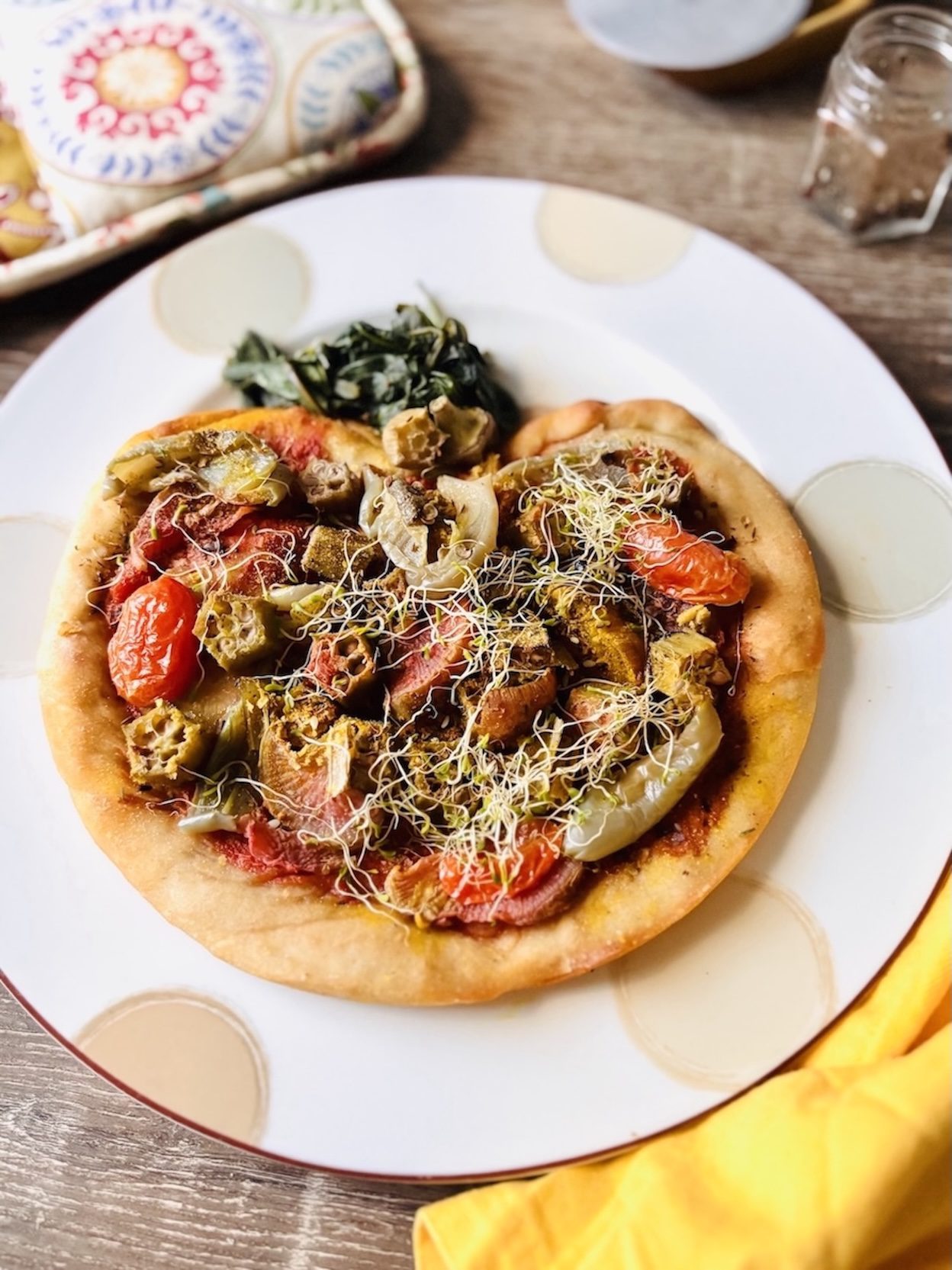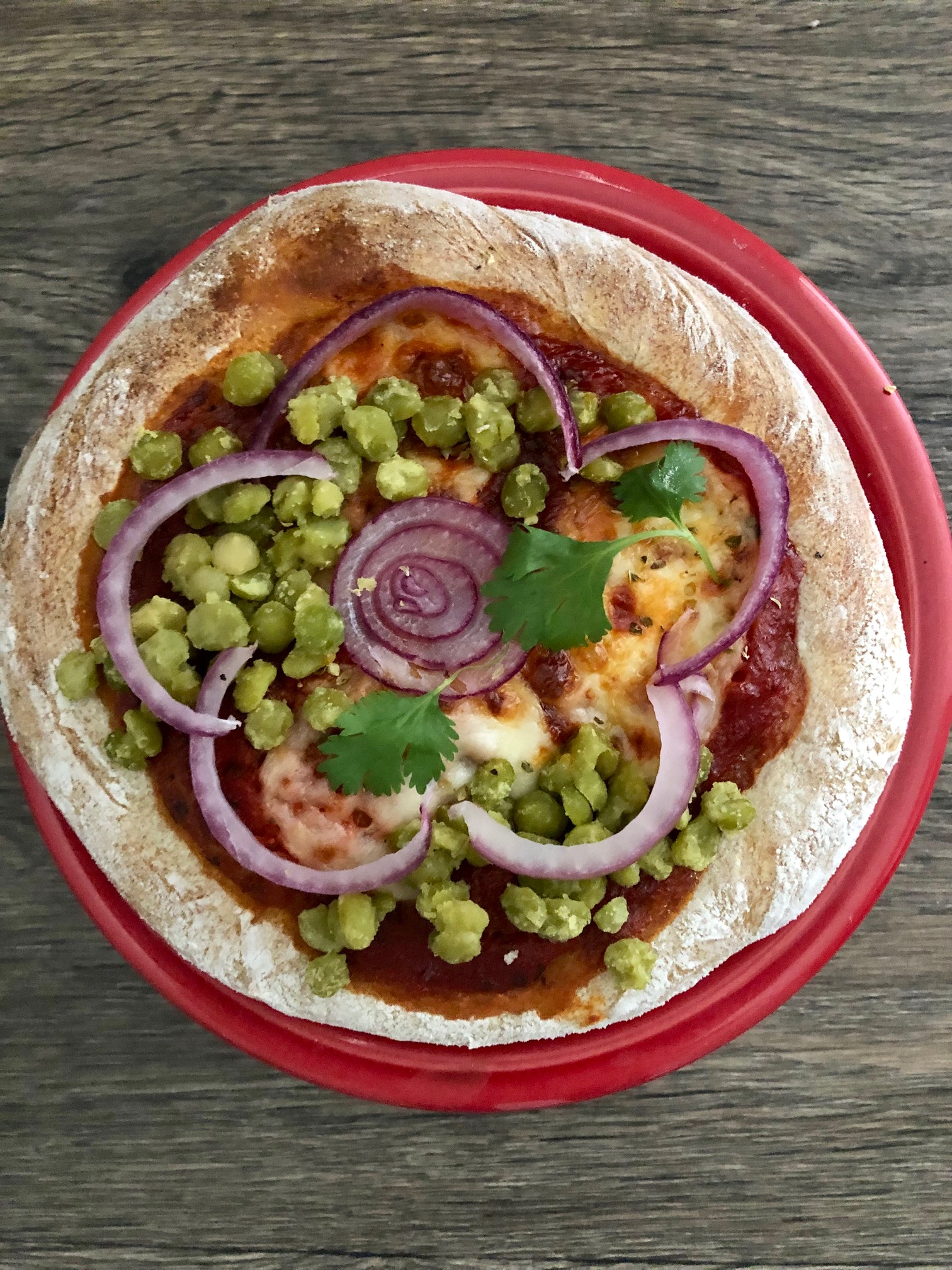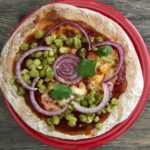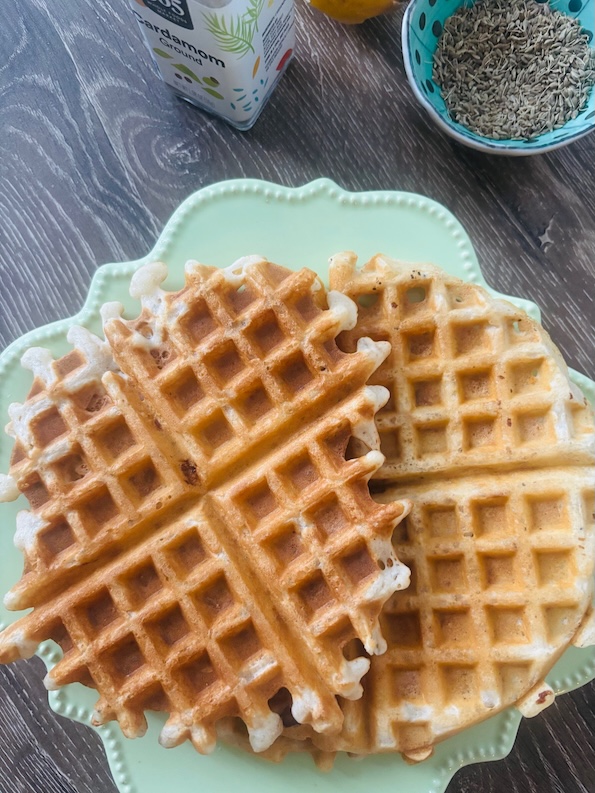Vegetable pizza is a plant-based pizza that can be made savory and interesting.
Or like this tomato-shaped farmers market okra, peppers, beets, and alfalfa sprouts pizza.
Microgreens like sprouts 🌱 are a great add to a veggie pie.

This one was made same-day and with “00” pizza flour that makes chewy crusts like those found in frozen pizzas. That’s what I found from baking in my home oven on regular baking temperatures.
That’s different than a commercial oven that I’m also familiar with.
You see, I’m not a beginner pizza maker or vegetable pizza maker…
I spent 4 of my pre-college years working for Domino’s Pizza making pizzas in busy stores around the DC metro suburbs.
The crusts were more like softer warming bread crusts, the kind that I am used to making at home these days. 😋
At the pizza shops, they were called the regular handmade pizza crust. Bread and handmade made for good comfort food. It made the bread soft and a little airy inside.
I was glad I could achieve a similar crust at home from techniques I tested and learned.
And similarly there’s no reason why you can’t make your own handmade pizza dough from your home or apartment oven. 💭
The recipes and steps for how to turn your pizza ideas to dream reality are easy to follow and you can also check out my Home Pizza Dough Beginner guide.
You can make your own easy pizzas from you home oven. And you can see some of my fall pizza regular and soft bread crust examples for ideas.
And you can also make slightly more advanced light and airy, charred pizza bread crusts (like those from wood-fired pizzas or “professional” pizza equipment).
Those are impressive and deliciously satisfying Neapolitan-style pizza that can come easily from your home or apartment oven! …Yasss! 🤸🏼♂️
I think pizza is an easy add anyway.
Especially because food costs have climbed a lot over the past years, and making your own home pizzas is a good way to save food and pizza money… and still get your satisfying pizza-fill on Game and pizza craving days.
Making pizza bread is as easy as 1-2-3 once you get the hang of it. It can be an auto-no-brainer with a few tries.
And that can be a regular healthy meal for you (more on this below)…
It’s also a way to impress your friends with your pizza kitchen skills like with this pizza that you may be surprised to know was made in my apartment oven with just a regular baking pan:
…So no fancy tools. And no wood-fired or outdoor pizza oven. What’s not to love? It did get gobbled up – leaving no crumbs.
And pizzas are also such an easy way to add more anti-inflammatory healthy plant-based foods to your diet.
A vegetable pizza is an easier sell than a plate of veggies (for any age) because not one ingredient is the star.
It’s the salty, savory ingredient melange that makes a pizza.
And it wins points for this old vegetable pizza maker! It’s happy and oh yeah, healthy…
Pizzas can be very healthy and low-fat if you don’t add as much “greasy” cheese as you see on most pizzas on the planet. In the pizza shops, our rule of thumb was one layer of oily cheese and no gaps. And that was a good amount of cheese you can pull apart.
But you can use a lot less cheese like in a Margherita pizza where healthy Buffalo mozzarella (yum!) slices are randomly added and the melted cheese patches don’t cover the entire pizza. It’s what you make it!
We also used in the pie shop, all our healthy scraps that fell in the pit for the everything pizzas. Those ingredients are just as healthy!
And you can do the same at home with very little pitfalls.
…Only pizza benefits.
Especially vegetable pizzas that make good beginner pizzas and are good opportunities to use all those veggies that the gardens are abundantly growing. 🍅 🥬
Pizzas are a great way to ramp up on onion and mushroom pairings as powerful immunity foods, especially during cold and flu season. 🧅🍄🟫
And if you’re dairy-free, you still can enjoy a pizza.
I remember there were always people who ordered no tomato sauce or no cheese… and even no dough…whaaat? That was before gluten-free was a thing.
And subbing those ways is all covered in my little 17-page guide. Because I believe there’s a pizza for any occasion! And can be enjoyed by anyone who can eat solids.
Oh, and I almost forgot… if you like sourdough or have never made before but interested in beginner learning skills, adding starter to your pizza dough is a great way, and for the crust’s sake that I cover as well.
It’s much easier adding sourdough starter in a pizza where it’s just a little bit and not a whole sourdough bread commitment.
Sourdough is also healthy because it’s lower glycemic index than doughs made from just commercial yeast. And that’s good for not spiking blood sugar (and helping prevent lifestyle/Diabetes 2 on the rise).
That’s just one reason why people are still so wild about the wild yeast and an added benefit for those who didn’t know!
That’s healthy food inspiration and ideal weight aspiration for anyone who has a gut and wants to keep it healthy. I’m pretty sure that’s all of us 🧡
Veggie Pizza
Ingredients
- 1 cup whole wheat flour (or combine with bread flour)
- water (enough to combine and have a slightly moist dough)
- 1 tsp salt (kosher salt recommended)
- 1/4 tsp instant yeast
Instructions
- Incorporate ingredients with either a mixer with a bread hook or do by hand. By hand, create a well (that looks like a volcano) in the middle of flour, yeast, and salt (like you would in homemade pasta making). Gradually add water and mix in.
- After combined, knead dough. Roll with hand and flatten with palm of hand. Do not be gentle. Do this for 5+ minutes.
- Let dough rest for at least 2 hours in a plastic container. Be sure the dough is moist. If baking same day, pull out and shape/flatten dough with hand leaving about 1/2" edge crust untouched.
- Bake at 350°F/180°F for 20 minutes and then pull out of oven and add sauce and vegetable toppings. For wet or frozen veggies, cook those separately in a pan before adding to pizza. Bake for another 10-15 minutes or until bottom of crust is fully baked.





